Politics, Patriots on the way... and a nightmare at Kupiansk
If there were ever any doubt, the politics surrounding Ukraine are... still not clear.
And if there is any doubt, consider the following (and treat these statements as an omen of further arguments to come):
- Russia chief of staff, Gen. Valery Gerasimov, said Wednesday (Sept. 18, 2025) that Russian forces are advancing on all fronts. This is true.
- Ukrainian President Volodymyr Zelenskyy stated simultaneously that Russia no longer has the capability to launch new offensives. This is also true.
- Russia is running out of men. This appears to be true.
- Russia has endless men (which is why it continues to advance on all fronts). This also appears to be true.
- The Pokrovsk to Kupiansk line that Yours Truly has worried over for more than 18 months is in danger of collapse, which would yield a massive gain for Russia. This (worryingly) appears to be true.
- US President Donald Trump has proven ineffective AND European leaders have wasted years with piecemeal sanctions (which indirectly were criticized with Trump's comments that Europe needs to first stop buying Russian oil before the US hits hard). And yes, this also appears to be true.
And there are other truisms: tanks have proven less and less effective; drones over Poland and then a loitering drone over Romania may well have backfired on Russia; the ZAPAD exercises in Belarus are more than they seem, but finally... the light at the end of the tunnel is beginning to show.
Stay tuned for that.
Russian gains... and troop numbers
First things first, reporting on the ground war is increasingly muddy. War bloggers have painted a constantly changing picture with this ranging from reports of gradual Russian gains to an impending hammer stroke backed by 150,000 fresh Russian troops to Ukrainian counters that have eliminated thousands in a single day. Moreover, the Russian military's statement this week that Russia is making gains literally everywhere is quite difficult to deny (and here, as I will note, the fall of Kupiansk is an imminent threat).
So perhaps--again--maybe a bit of everything is true. But also, perhaps a bit of everything is... off the mark.
In an effort to gain much-needed clarity, The Corners reached out to key sources who have participated in fighting on various fronts since the first days of the war. Noteworthy, much has changed during that time--Russian meat waves have morphed into quad attacks, but also a kind of semi-suicidal infiltration technique described as follows: many 'advances' are essentially Russians slipping through in twos and threes under heat cloaking. As one source stated, "this happens until suddenly you have 30 of them on your flank or behind you.
"At this point, we root out these groups, and when they are hit and lose their leadership they tend to just wander around lost."
This de facto explains some "advances" that seem to appear and disappear, and many are reported based on the geo-location of videos, with many of these being drone videos actually depicting the elimination of both Russian and Ukrainian ground troops. This also explains delayed mapping by Deepstate UA and also the at time overly aggressive mapping by pro-Russian bloggers.]
Yet this does happen constantly, and at times this appears to happen on scale. This begs the question: has the Russian summer offensive come to an end? This does not appear to be the case (yet)--even as sources roundly state that Russia simply does not have the men to dynamically break through Ukrainian lines and keep the offensive going.
That said, there are Russian gains, and said gains are reason to worry. These I will discuss in the back third of today's post. Again, stay tuned.
So is there a shortage... or not?
In short, the above does not mean that Russia has less men en total than Ukraine--not at all, and that would be an absurd statement from the get go. By hook and crook Russia is indeed still finding men to fill uniforms. But what kind of men?
Here is the question (which seems repeatedly answered during fighting at the various fronts). As told directly to me by a former special forces operator, the physical demands to fight under current conditions are beyond extreme. Imagine moving primarily during rain and at night and under cover to hide from omnipresent drones. Movement in tree lines may seem logical, but trees are often massively felled, which means crawling over and over downed trunks, through brush and rubble and all of this done under immense pressure in contrary to the elements. Once a mission is accomplished, there is the high-speed struggle to get back to Ukrainian positions--again under drone attack and potentially dragging wounded.
"This pushes you to the absolute brink of what you can do physically," the source said. "Russia does push troops forward, but they are finding it increasingly difficult to source men who are fit--and training to carry out complex operations is nil."
True, once a group of Russians does infiltrate, the suicide machine pushes other troops madly into gaps, real or fictional, and Ukrainian defenders also face artillery, glide bombs and aggressive drone attacks, which means that they may need to fall back simply to avoid entrapment from above. That said, this does give a glimpse as to just why Russian gains have still failed to result in a victory after three years of an altogether fruitless war.
Yet Russia does continue to push forward, and it still does find men--and, somewhat obtusely, the Zapad 2025 Russian-Belarussian military exercises, which prompted Poland to send 40,000 troops to the border and Nato to obsess over the Suwalki Gap, are proof of that.
Zapad and the Baltics...
So let's talk war games. Russia typically declares an absurdly low number of troops for Zapad (under 13,000), which is, again, a standard Russian move (as absurdly transparent as it seems) to avoid the need for international observers. That said, reports on Zapad have noted that 1) international observers have taken part--with this including even US military and 2) more than 100,000 Russian troops and even a sizeable naval presence have also taken part, with full-scale mock battles having taken place in what appears to have been an effort to intimidate both Nato and the bordering countries belonging to Nato and the EU.
The sizeable presence of military is eerily reminiscent of Zapad exercises months prior to the 2022 invasion of Ukraine, and everyone from bloggers to pundits will be closely watching whether troops are moved back to hot points, such as Pokrovsk, or whether they remain in Belarus, which could signal a second front or even an assault on the Baltics.
And before the naysayers begin, this is serious stuff. Remember: once Russia actually has boots on the ground, it does not bluff. This is a country that even in the best of times only moved large masses of troops in order to begin a military assault. Call it Russian pragmatism or call it the unstoppable wheels of war--in the sense that once Russia sets said wheels in motion, there will be follow through, as this is a not a country that appears to know how to reverse course.
[Ed. note--stay tuned for the follow-up, but there is good news here, as despite Russian declarations that a total of 100,000 troops would take part at ZAPAD 2025 and that there would be a naval presence (which did leave Yours Truly scratching his head) have turned out to be more Russian fibbing. Putin appears to have "included" troop exercises in Kalingrad and the launch of missiles... from one frigate in the Barents Sea. Estimates now vary widely regarding actual troop participation, with this running from 15,000 to 30,000.]
To be honest, I am meanwhile clinging to prayers that history will be somehow repeated--that after three years of war and economic hardship Russia will see internal revolution and collapse out of the war. Not to digress, but there is a precedent: the current scenario (much like the scenario prior to the invasion) continues to mirror... World War I. Note that Yours Truly did remark on this in the run-up to the invasion, as, just as in the days leading up to the First World War, the various machinations of the various protagonists (although especially Germany, with its adherence to train schedules and military doctrines and overall plans) set a course for disaster that seemingly could not be reversed. Much like Germany at that time, once the troops were "put into the system"--i.e. moved toward the front--the invasion would go forward.
Yet the current Russian trajectory also remains similar to the First World War: a strong leader who simply was not as strong as he thought faced a variety of obstacles that in the end meant failure and revolution. If you do not want to listen to me, just ask AI (or actually, I will do this for you).
Q: Why did Russia fail during WW1?
Russia's failure in World War I was due to a combination of deep-seated pre-war weaknesses that were exacerbated by the conflict, leading to massive military defeats, severe economic collapse, and social unrest that culminated in the collapse of the Tsarist regime and the Russian Revolution in 1917. Key factors included a poorly equipped and trained army facing an industrially superior enemy, severe logistical and transport failures that hindered supply, widespread shortages of munitions and supplies, incompetent military leadership [...]
Or spelled out:
Poor Equipment & Supplies:
Russia's army lacked adequate modern weaponry and munitions, particularly rifles and ammunition, to match its industrialized German and Austro-Hungarian opponents.
Incompetent Leadership:
Military leadership was drawn from a narrow, aristocratic circle and was ill-suited for modern warfare, leading to strategic errors and heavy casualties.
Poor Training & Logistics:
Many reservists received minimal training, and Russia's primitive transport network couldn't deliver supplies to the front, leading to shortages and disorganization.
Widespread Casualties:
Russia suffered enormous losses of both men and territory, with soldiers suffering under poor conditions and a lack of necessities.
Industrial Backwardness:
As a largely agricultural nation, Russia couldn't compete with the industrialized powers' war production.
Transport Network Collapse:
The railway system, crucial for moving troops and supplies, failed to cope with the demands of the war, creating widespread food and fuel shortages in cities.
Economic Disruption:
The war's strain exacerbated existing economic problems, leading to inflation, food shortages, and increased hardship for the population.
Political Instability:
The failures and immense human cost of the war eroded public trust in the Tsarist regime, which had lost legitimacy, leading to widespread discontent
Sound familiar? True, Russia's economy is no longer agriculturally-based, but substitute agro-revenue for... that of an increasingly hampered oil sector, and the comparison should raise eyebrows indeed.
[Ed. note--yes, I am quite serious here, as 1) Putin cannot motivate the Russian masses a la Stalin simply because Ukraine did not invade Russia, and 2) three years of pressure, which includes sanctions, asset seizure and now serious damage to oil infrastructure to the point that Russia's Transneft has admitted it must scale back international deliveries still would seem a good time-line for implosion--again, not so unlike... that seen in World War 1. ]
But to finally and ultimately answer the question: yes, Russia can still find men. Indeed, the buildup at Pokrovsk possibly originally numbered 150,000, but with estimates of the summer offensive having cost Russian up to 250,000 soldiers, there are questions as to whether even half that number (at Pokrovsk) remains. But skilled soldiers who can mount effective offensives supplied with competent logistics under attack from Ukrainian drones and military on the ground? This seems increasingly unlikely.
Now could Russia launch new attacks both in Ukraine and in the Baltics in an effort to intimidate Nato and the West?
Unfortunately, yes, it could.
The Baltics and Scandinavia...
Massive losses in Ukraine aside, countries bordering Russia are not of the belief that the threat is illusory. Let's start with Finland. Back in August Finland announced it was fortifying its 1,300-kilometer border with Russia, although the focus here seemed to be at least in part an effort to stop illegal migration of the kind that has plagued Poland and which forced it to build a series of fences and barriers along its border with Belarus. This came primarily in response to Belarus attempting to weaponize migration by luring individuals and families from third-world countries with a promise of easy access to a wider Europe--at which point Belarussian border guards and secret services would drive said migrants to the Polish border and attempt to force them across or at least drive them into the wooded no-man's land between the countries to "demonstrate" Poland's alleged disdain of human rights.
That said, Finland has never minced words when it comes to Russian aggression, with the government having called Russian statements that Nato is the problem "complete bollocks." Likewise, Finnish Prime Minister Petteri Orpo again only days ago noting the "failure" of the Russian war on Ukraine, pointed out not only the high casualty rate and damaged Russian economy, but that both Sweden and Finland have now joined Nato.
Finland has also refused to remain passive. In August Nato set up a command center 140 kilometers from the border in Mikkeli, which, according to Deputy Chairman of Russia's Security Council Dmitry Medvedev means potential Finnish aggression--and signals of a Russian buildup there.
This has also not been lost on Orpo, whose government has now earmarked some EUR 6 bln for military modernization and border defense.
Yet another development has materialized in Estonia, Lithuania and Latvia, with Lithuania announcing in August that it was building a three-layered defense line, and European Commission President Ursula von der Leyen calling for a "drone wall" on the EU's border with Russia that would include surveillance drones and satellite monitoring. Estonia and Lithuania have also sorted EUR 14 bln under the EU SAFE program (with Poland allocated another EUR 43.7 bln), with a portion of this likely allocated to the "drone wall."
Here it should be said that Estonia has long been known to have an aggressive intelligence service, which has typically been on the mark in the past with regard to Russian short-term and long-term designs. Meanwhile, there are whispers of relief with regard to Lithuania, which is seen by some sources to have remained woefully unprepared for Russian aggression, the logic seemingly being that of wanting to avoid decimation seen in Ukrainian cities through...
Well, it's hard to say. Wishful thinking?
But ask yourself: which is more troubling? The previous alleged lack of preparation and wishful thinking or the current rush to create a three-tiered defensive line under the belief that yes, the Russians will eventually invade?
You can pick your poison, but either one will still make you sick to your stomach.
Drones and yet more politics...
First things first, US President Donald Trump has shown no sign of playing hardball with Russian President Vladimir Putin--and his statement that maybe Russia "made a mistake" with regard to the 19 drones that crossed well into Polish airspace was evidence of that.
Big surprise.
Now second things second, drones over Poland and a loitering drone over Romania does not seem to have had the effect that Russia anticipated. It appears to have been assumed that EU/Nato countries would hold off on further support of Ukraine, sensing a need to bolster home defense. Yet Europe's reaction has been nuanced. Not only have the Baltics gotten serious about the Russian threat, but "home defense" appeared to take on new meaning with Denmark's announcement that it would buy long-range, precision weapons to counter what it considers a long-term threat.
Danish Prime Minister Mette Frederiksen's statement Wednesday, representing a "paradigm shift" in defense strategy set off a war of words, with Russian representatives calling the move "pure madness." [Expect this to be followed up by standard Russian threats of nuclear strikes, which actually will bolster Danish moves.]
Moreover, Denmark has also moved to allow the Ukrainian drone manufacturer Fire Point to set up production in... Denmark. This will be the first time a Ukrainian arms manufacture has set up in a Nato country. And yes, the Russians are livid. Considering that this comes following Russian threats against the EU over the possibility of diverting frozen Russian assets to help Ukraine, well, the times are a changing.
And yet there is more, while Trump appears to be doing little to nothing to support Ukraine--and while this has been quite under the radar--Patriot missiles and HIMARS rocket systems have been included in the long-debated (and now green-lighted) program that allows EU countries to pay for such systems in order that they be sent to Ukraine.
There are two points to make here--these reportedly will be the first shipments that had not already been signed off by the Biden administration, and also 2) this is no small order either, as at least USD 2 bln in funds have been earmarked, and this may soon reach closer to USD 4 bn. And according to Ukrainian sources, the first weapons in the package are already on the way.
Now for the bad news--i.e. the Kupiansk front...
Yes, I said it and I will say it again: now for the bad news. Despite all of the above, despite anything stated about Russia's inability to put together new offensives, Russian President Vladimir Putin is on the edge of a victory--a goal Russia has been seeking for probably close to two years. This actually does not negate any of the above, nor the fact that Europe appears to be getting serious with regard to Russian aspirations--and nor does it mean that this war is anything but a strategic fiasco for Putin himself--but it will hurt just the same.
And if the Kupiansk to Pokrovsk line fails--both the loss of land and damage done to Ukraine long-term... may be irreversible.
A thought that chills me to the bone.
Readers will note that I anticipated holding off on updates for a week or more (or even a few), due to the vicious battles ongoing across several fronts, with the vast majority of observers focusing on Pokrovsk and how Russian forces managed a serious breakthrough there.
At that time, I again noted the threat of Ukraine holdings east of the Pokrovsk to Kupiansk "logistics line," and long-term readers will also remember that I have feared for these holdings since the Trump administration turned off the lights on Ukrainian special forces during the ill-fated Kursk counteroffensive earlier this year.
But if you do not remember, I stated that killing satellite feed and effectively rendering Ukrainian forces blind would not only cost Ukraine the Kursk gains, but also would allow Russia to focus on Pokrovsk and thus endanger the entire Pokrovsk-Sloviansk-Kramatorsk-Borova-Kupiansk line.
Unfortunately, this prediction is ever closer to proving accurate.
As this has been a tremendously long blog, I will keep this short. Despite being stopped at the Sumy front, Russia is making various gains--these include at Vovchansk (the Kharkiv front), which has put Kharkiv within or close to within long artillery range; at Zeleny Hal in Zaporizhzhia and it is quite likely that a new Russian surge will be launched on the Orkhiv front/north of Robotyne. None of these should be simply brushed off, but yes, our focus will remain at Pokrovsk to Kupiansk.
As a review, here are two maps I posted from Aug. 30. The blue line--although already broken--represents the defense/logistics line I have harped on for 18 months. Everything between that blue line and Russian held territory is up for grabs. In order for this to be better understood, first is Kupiansk to the south all the way to Sloviansk, and below that is the Kramatorsk to Pokrovsk screen shot from the same date.
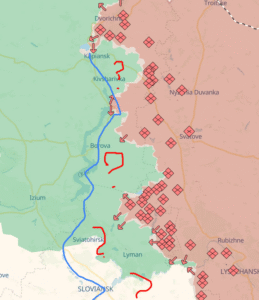
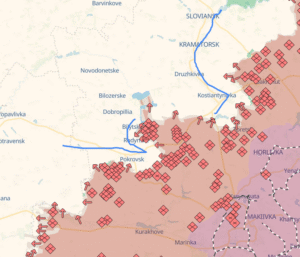
Obviously, this is not pretty.
At that time, the focus was, again, on the Russian penetration north of Pokrovsk. In hindsight, this appears much as sources described it. Russian infiltrators managed to gain footholds that were followed by near-suicidal pushes from reserve troops. These were met with Azov forces, and although Azovs likely took heavy casualties, Russian forces were in a capricious situation even back at the end of August, as can be seen below:
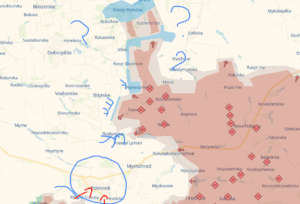
Since the above screen shot, Russian forces have been encircled or partially encircled. Flash to today's map and the following is clearly seen (which has been corroborated by bloggers and independent sources):
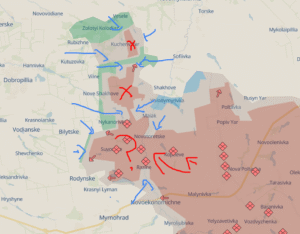
Note the red "X's", which represent Russian forces either encircled or partially encircled. Some Ukrainian sources have reported that the Russian forces furthest north have been all but obliterated, but it appears that even Russian forces at the "?" point in the map are in danger of being cut off--although reports depict outrageously bitter fighting there.
This represents even now a victory of sorts. But a leap to Kupiansk at the far end of the sector denotes a near emergency, with the situation appearing to disintegrate by the day. Below is the Kupiansk front as of Sept. 12, 2025, followed by a close up of Kupiansk itself from the same day, which reveals that the northern part of the city had at that time either fallen into Russian hands or it was heavily disputed:
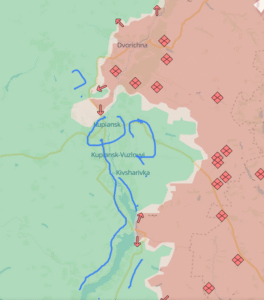
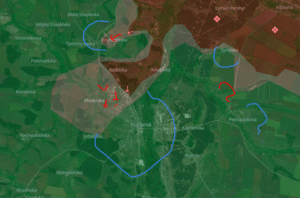
Today (Sept. 18, 2025), the situation has become far more dire. Note below that not only have Russian forces driven deep into the city, but they are close to taking the center itself--which is a natural hub for supply lines/roads for the entire sector (highlighted in blue):
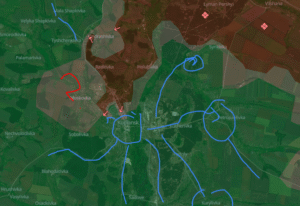
A wider view reveals the danger--and the Ukrainians may have no choice but to pull out of long-held positions, such as Synkivka not only due to the Kupiansk threat, but also due to a possible collapse of Ukrainian lines seen on the map north of Pischane. Note that this collapse/this Russian advance may have come... due to supply difficulties. In fact, it can be assumed that the thought of a massive pullout from the territory highlighted in blue (while this is still possible) must have already crossed the minds of the Ukrainian general staff.
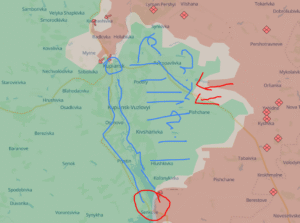
But still a wider view reveals even more trouble. Below is the current situation running down to Sloviansk, and Ukrainian held territory is more and more beginning to reveal "pockets" stuck between Russian lines and the Oskil waterway.
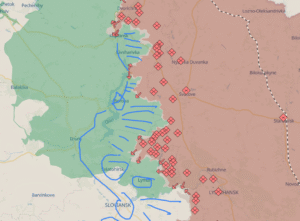
Does this mean the Ukrainians will give up this territory without a fight? Absolutely not. Does this mean it's time to panic.
Maybe a bit.
Yet to get a fuller picture, below is the current view from Pokrovsk north to Sloviansk to Borova:
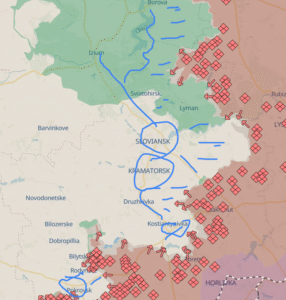
And if you cannot see it, let me spell it out: maybe it's not time to panic, but it's close. The current situation is critical. It is highly possible that (taking into account that Russia may now be moving forces from the standoff in Sumy to Pokrovsk) that not only will Pokrovsk eventually fall, but so will Kupiansk. This is not exactly a deck of cards, but the immediate cities north of Pokrovsk (Kostiantynivka, Kramatorsk, Sloviansk) will be difficult to supply and hold, to say nothing of territory running from Lyman to Borova and the Kupiansk pocket (which is essentially what this is).
And maybe this does not equate to a Russian breakthrough and lightning strike that could again threaten the rest of the country, but such losses would be a monstrous burden to bear. And yes, I do mean politically as well.
Which means the European Nato countries need to step up and step up quick. As do the Americans. Get them Patriots, but also get the HIMARS, more Bradleys. And think about A10s.
Or put succinctly, the Ukrainians need saving now--before it's too late.
Preston Smith is a licensed investigator based in Gdansk, Poland. He can be reached at query@cddi.pl.
All maps courtesy of Deepstate UA.
Kupiansk photo from April 2025 credit: Dsns.gov.ua, CC BY 4.0 <https://creativecommons.org/licenses/by/4.0>, via Wikimedia Commons.



martin_earl@yahoo.com
1 miesiąc agoGood report, but not good news! At least 1 date by the maps notes August - we are in September!
Preston Smith
1 miesiąc agoThanks--you are not the only person to have caught that date, and I have since changed it for accuracy purposes. Obv, was a bit fatigued when I wrote this one. Thanks for reading!